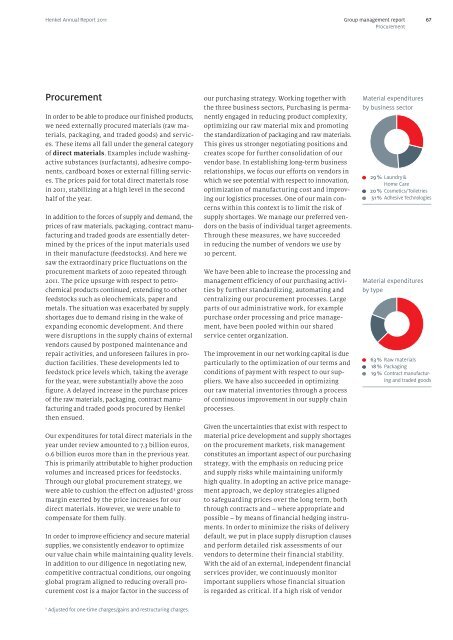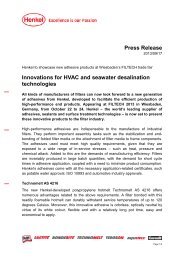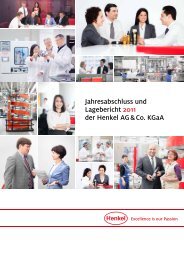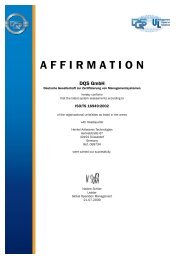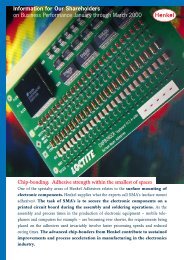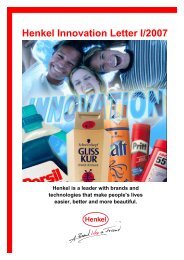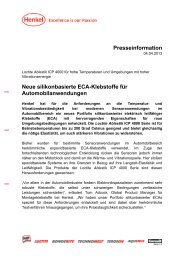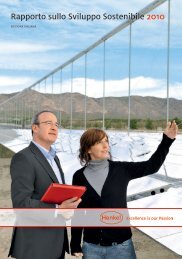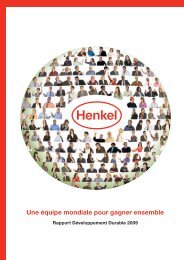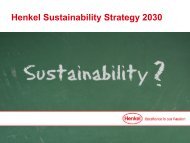Henkel Annual Report 2011 - Henkel AG & Co. KGaA Annual Report ...
Henkel Annual Report 2011 - Henkel AG & Co. KGaA Annual Report ...
Henkel Annual Report 2011 - Henkel AG & Co. KGaA Annual Report ...
You also want an ePaper? Increase the reach of your titles
YUMPU automatically turns print PDFs into web optimized ePapers that Google loves.
<strong>Henkel</strong> <strong>Annual</strong> <strong>Report</strong> <strong>2011</strong><br />
Procurement<br />
In order to be able to produce our finished products,<br />
we need externally procured materials (raw materials,<br />
packaging, and traded goods) and services.<br />
These items all fall under the general category<br />
of direct materials. Examples include washingactive<br />
substances (surfactants), adhesive components,<br />
cardboard boxes or external filling services.<br />
The prices paid for total direct materials rose<br />
in <strong>2011</strong>, stabilizing at a high level in the second<br />
half of the year.<br />
In addition to the forces of supply and demand, the<br />
prices of raw materials, packaging, contract manufacturing<br />
and traded goods are essentially determined<br />
by the prices of the input materials used<br />
in their manufacture (feedstocks). And here we<br />
saw the extraordinary price fluctuations on the<br />
procurement markets of 2010 repeated through<br />
<strong>2011</strong>. The price upsurge with respect to petrochemical<br />
products continued, extending to other<br />
feedstocks such as oleochemicals, paper and<br />
metals. The situation was exacerbated by supply<br />
shortages due to demand rising in the wake of<br />
expanding economic development. And there<br />
were disruptions in the supply chains of external<br />
vendors caused by postponed maintenance and<br />
repair activities, and unforeseen failures in production<br />
facilities. These developments led to<br />
feedstock price levels which, taking the average<br />
for the year, were substantially above the 2010<br />
figure. A delayed increase in the purchase prices<br />
of the raw materials, packaging, contract manufacturing<br />
and traded goods procured by <strong>Henkel</strong><br />
then ensued.<br />
Our expenditures for total direct materials in the<br />
year under review amounted to 7.3 billion euros,<br />
0.6 billion euros more than in the previous year.<br />
This is primarily attributable to higher production<br />
volumes and increased prices for feedstocks.<br />
Through our global procurement strategy, we<br />
were able to cushion the effect on adjusted 1 gross<br />
margin exerted by the price increases for our<br />
direct materials. However, we were unable to<br />
compensate for them fully.<br />
In order to improve efficiency and secure material<br />
supplies, we consistently endeavor to optimize<br />
our value chain while maintaining quality levels.<br />
In addition to our diligence in negotiating new,<br />
competitive contractual conditions, our ongoing<br />
global program aligned to reducing overall procurement<br />
cost is a major factor in the success of<br />
1 Adjusted for one-time charges/gains and restructuring charges.<br />
our purchasing strategy. Working together with<br />
the three business sectors, Purchasing is permanently<br />
engaged in reducing product complexity,<br />
optimizing our raw material mix and promoting<br />
the standardization of packaging and raw materials.<br />
This gives us stronger negotiating positions and<br />
creates scope for further consolidation of our<br />
vendor base. In establishing long-term business<br />
relationships, we focus our efforts on vendors in<br />
which we see potential with respect to innovation,<br />
optimization of manufacturing cost and improving<br />
our logistics processes. One of our main concerns<br />
within this context is to limit the risk of<br />
supply shortages. We manage our preferred vendors<br />
on the basis of individual target agreements.<br />
Through these measures, we have succeeded<br />
in reducing the number of vendors we use by<br />
10 percent.<br />
We have been able to increase the processing and<br />
management efficiency of our purchasing activities<br />
by further standardizing, automating and<br />
centralizing our procurement processes. Large<br />
parts of our administrative work, for example<br />
purchase order processing and price management,<br />
have been pooled within our shared<br />
service center organization.<br />
The improvement in our net working capital is due<br />
particularly to the optimization of our terms and<br />
conditions of payment with respect to our suppliers.<br />
We have also succeeded in optimizing<br />
our raw material inventories through a process<br />
of continuous improvement in our supply chain<br />
processes.<br />
Given the uncertainties that exist with respect to<br />
material price development and supply shortages<br />
on the procurement markets, risk management<br />
constitutes an important aspect of our purchasing<br />
strategy, with the emphasis on reducing price<br />
and supply risks while maintaining uniformly<br />
high quality. In adopting an active price management<br />
approach, we deploy strategies aligned<br />
to safeguarding prices over the long term, both<br />
through contracts and – where appropriate and<br />
possible – by means of financial hedging instruments.<br />
In order to minimize the risks of delivery<br />
default, we put in place supply disruption clauses<br />
and perform detailed risk assessments of our<br />
vendors to determine their financial stability.<br />
With the aid of an external, independent financial<br />
services provider, we continuously monitor<br />
important suppliers whose financial situation<br />
is regarded as critical. If a high risk of vendor<br />
Group management report<br />
Procurement<br />
Material expenditures<br />
by business sector<br />
29 % Laundry &<br />
Home Care<br />
20 % <strong>Co</strong>smetics/Toiletries<br />
51 % Adhesive Technologies<br />
Material expenditures<br />
by type<br />
67<br />
63 % Raw materials<br />
18 % Packaging<br />
19 % <strong>Co</strong>ntract manufacturing<br />
and traded goods


